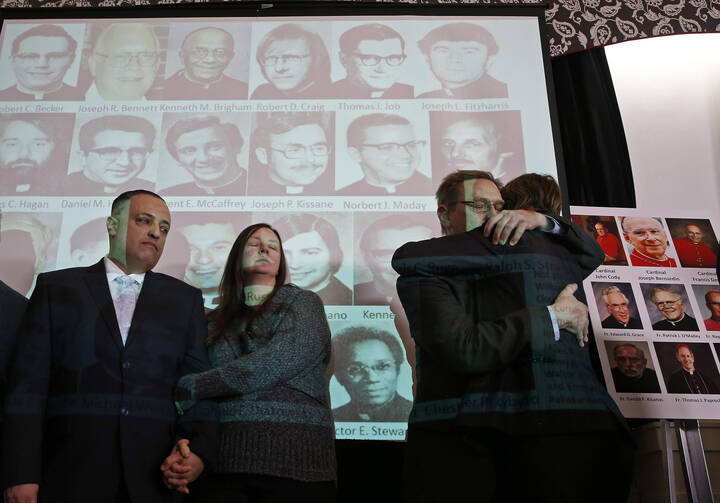The U.S. bishops on April 17 released the results of their annual compliance audit intended to track the U.S. church’s response to the abuse of children by clergy according to guidelines first established by the 2002 Dallas Charter.
During the 2014 audit year (July 1, 2013–June 30, 2014), 620 survivors of child sexual abuse by clergy came forward for the first time to make 657 allegations: 130 cases were substantiated; 62 were unsubstantiated; 243 were still under investigation; 210 were unable to be proven or disproven; and 12 were “other.”
Of all the allegations, 37 were made by current minors; the remaining 620 were made by adults who had been abused in the past. Of the 37 allegations made by current minors, all were reported to civil authorities, who found six substantiated; 11 unsubstantiated; 12 unable to be proven. The investigation was ongoing in eight other cases.
The U.S. Catholic Church spent a total of $150,747,387 in costs related to child protection efforts and to allegations of clergy sexual abuse of minors in dioceses and religious orders between July 2013 and June 2014, including $119,029,647 on settlements paid to victims, therapy for victims, attorneys’ fees and other costs related to allegations. It spent $31,667,740 on safe environment training programs, background checks and other protective efforts.
According to a survey by Georgetown University’s Center for Applied Research in the Apostolate (CARA) included in the annual audit report, over 80 percent of credible allegations of abuse reported between July 2013 and June 2014 date back over 25 years, with the majority occurring from the 1960s-80s. According to responses gathered by CARA from all but one of the 195 dioceses and eparchies in the United States, two of the 294 credible allegations of clergy sexual abuse of minors made during this time occurred in 2014. The remaining credible allegations date back as early as the 1920s.All new cases were reported to civil authorities.
The audit reports that during the audit period, the U.S. church:
Trained 98 percent of its two million volunteers, employees, educators, clergy and candidates in parishes in how to create safe environments and prevent child sexual abuse.
Prepared more than 4.4 million children to recognize abuse and protect themselves.
Ran background checks on close to two million volunteers and employees, 51,314 clerics and 6,568 candidates for ordination.
Though the audit indicates a continuing decline in new allegations of abuse, it shows an increase in the reports of “boundary violations.” The report’s authors suggest the increase may be an indication that safe environment training is making children more likely to report behaviors that make them uncomfortable.
StoneBridge Business Partners, the auditors, found that dioceses/eparchies are implementing the Charter through appropriate policies, procedures and practices. They also noted some deficiencies and weaknesses: hesitation to participate in parish audits or surveys, inconsistent collection and reporting methods, incomplete or inaccurate audit documents, and failure to participate in the audit process. According to the report: “Many of these issues are not dioceses/eparchies acting out of contempt or willful disregard for the requirements of the Charter; rather, they are caused by a sense of complacency”—what survey authors described as instances of institutional “drift.” They add, “This drift has been edging in over the years and is becoming the enemy of the Charter.”
Record keeping, conducted voluntarily by the dioceses themselves, remains an issue, according to the report. It notes ,“It is important to recognize that since the first audits, record keeping involving both training and background checks was cited as a problem. Yet, twelve years later, those recordkeeping problems continue to exist.”
“While substantive progress has been made, it should not be concluded that the sexual abuse of minors is a problem of the past that has been adequately addressed,” Francesco C. Cesareo, PhD, Chair of the National Review Board for the Protection of Children and Young People, wrote in a letter introducing the report to the U.S. bishops. “The fact that there were six substantiated cases of abuse of current minors in this year’s audit is indicative of the fact that there are still instances where dioceses fall short. Dioceses/eparchies can easily fall victim to complacency, as the requirements of the Charter become the modus operandi of the life of the Church. This complacency, or false sense of security, is something that bishops need to guard against. There must be a renewed commitment each day to being diligent in the implementation of the Charter to avoid drifting from what is expected of the bishops.”
Archbishop Joseph E. Kurtz of Louisville, Kentucky, president of the U.S. Conference of Catholic Bishops, said the report clearly shows the need to remain vigilant in the protection of children. “Though our promise to protect and heal made in 2002 remains strong,” the archbishop said in a statement releasing the audit findings, “we must not become complacent with what has been accomplished. It is my hope and prayer that as we continue to fulfill our promise, the church will help model ways of addressing and bringing to light the darkness and evil of abuse wherever it exists.”
Auditors again expressed concern about those Diocese of Lincoln, Neb., and several epicaries, which have refused to participate in the annual audit. “We cannot emphasize enough,” they wrote, “the harm to the Church caused by these compliance issues, as well as nonparticipation. What happens in one diocese/ eparchy is frequently interpreted as happening in all dioceses/eparchies, and this results in all bishops being wrongly judged. When one diocese/eparchy fails to use all available means to protect children, not only is it perceived as a national phenomenon, but also as a lack of commitment by the bishops to take seriously the Charter and the protection of children.”








